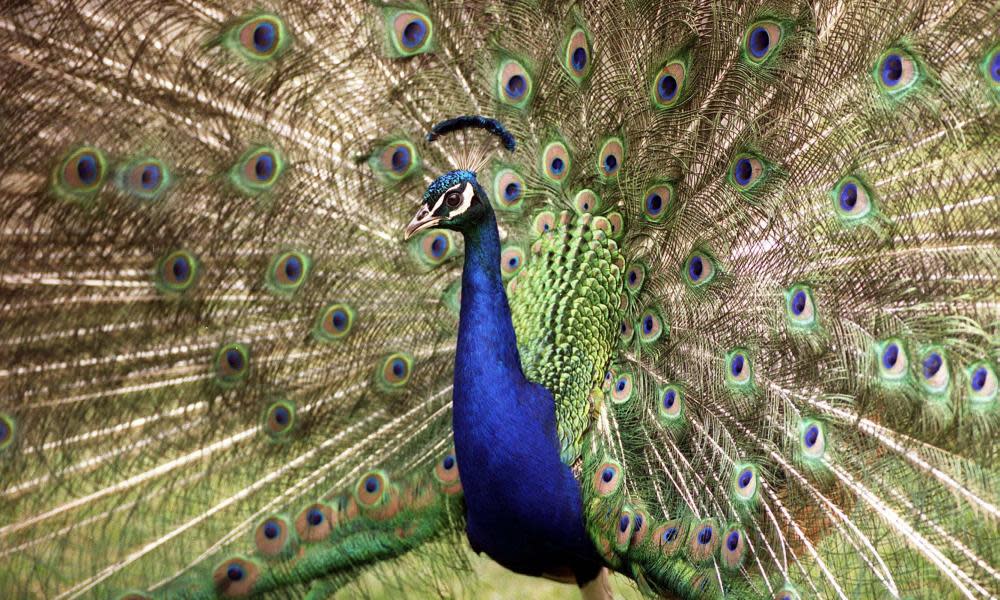'No predators, plenty to eat': New Zealand struggles with plague of peacocks

A bird renowned around the world for its beauty has showed its ugly side by causing havoc on farms in New Zealand; eating crops, evading control efforts and driving landowners to distraction.
The jade and green peafowl, commonly known as the peacock, has become naturalised in New Zealand after what New Zealand Birds Online calls “benign neglect of birds kept for display”.
Preferring rugged and wild habitats, the peafowl has spread extensively around the warmer regions of the North Island, according to the Ornithological Society of New Zealand, and has also been recorded as far south as Christchurch and Dunedin.
Related: 'Jet fighter' godwit breaks world record for non-stop bird flight
But as the numbers of their natural predators such as possums, ferrets, stoats and rats drop due to nationwide control efforts, peacocks are becoming increasingly destructive. Many local farmers have also unwittingly planted feasts for peacocks; seeding fields of maize, corn and clover which is beloved by the animals.
Farming accounts for around 5% of New Zealand’s gross domestic product.
“They weren’t a problem at all when there were plenty of predators around, but now they’ve got hardly any predators and plenty to eat,” said Wanganui farmer Grant Adkins, a spokesperson for Federated Farmers in the region.
“They love rye grass and clover. They’re happy to wander around and eat all the fresh, green shoots of all our pastures and crops – they do very nicely.”
Adkins estimates the number of peafowl is in the thousands in his district, and says authorities have shown no interest in controlling their numbers; focusing instead on targeting pests like possums and rats.
According to NZ Birds Online, other large sightings include up to 100 birds spotted in a field at Orere Point, in April 2011, and more than 100 near Otane in the central Hawke’s Bay in June 2016.
Farmers have tried to manage growing numbers by shooting the birds, but the task is difficult as the birds are clever and known to be “very wary in feral populations”.
Related: More murder hornet nests suspected after first on US soil eradicated
No poisons have been certified for the specific use of peacocks. Once shot at by farmers, they learn to keep their distance.
“Over a 12-year period, their numbers have increased hugely and they are spreading further and further afield,” says Adkins. “There are thousands in the district. On the flats of my neighbours, I can see a group of 150 in one go, eating a lot of grass. The amount of feed they’re eating is feed our livestock can’t eat.”
‘They’re like blimmin’ road runners’
Tony Beauchamp, an ornithologist, says New Zealand’s feral peacocks are a rare phenomenon globally, as the birds mainly live on the Indian subcontinent.
Knowledge about peacocks in New Zealand is scant, with the birds preferring to live in wild and remote regions of the country, and the government’s conservation efforts firmly focused on protecting native species.
“Most people in New Zealand ignore introduced birds, it’s a New Zealand thing,” says Beauchamp.
“I think a lot of our farm management practices are encouraging higher numbers of certain introduced birds. In Northland, farmers have been planting maize for stock feed. But maize is absolutely dynamite for pest birds, they love moving into it.”
Beauchamp says ornithologists only began studying native birds with gusto in the 1960 and 1970s, meaning the country is “still playing catch-up” in its bird knowledge, perhaps leading to oversights in the study of introduced species.
“I am not sure [peacocks] are very well understood,” says Beauchamp.
The New Zealand government has committed to completely eradicating invasive species such as rats, stoats and possums by 2050. Trapping the unwanted species has become a mainstream hobby in New Zealand, helped by possum fur being valued in the fashion industry.
But as possum numbers drop, Adkins says peacock numbers have boomed. Possums, ferrets, stoats and rats often eat the eggs of peacocks, which build nests on the ground.
“They’re pretty smart, as soon as one starts to move, they all run, they’re like blimmin’ road runners,” says Adkins.
“And once they’ve learnt they’re being shot at, you won’t get within two or three hundred metres of them.”
Beauchamp agreed that peafowl in the wild were “extremely wary” and will keep a distance of 500 metres if they sense a threat.
Rod Smillie, Horizon regional council’s biodiversity, biosecurity and partnerships manager, said he was “aware” of a population of wild peacocks in the region.
“Peacocks do cause damage to pasture and crops,” Smillie said in a statement but added they were not included in the council’s pest management plan, which would be reviewed in 2027.
A spokesperson for the department of conservation based in Whakatāne said peafowl were “not a significant conservation issue”.
In the South Island, there have been isolated reports of peafowl escaping home enclosures, and Adkins is worried that left unchecked, the birds will spread around the country.


